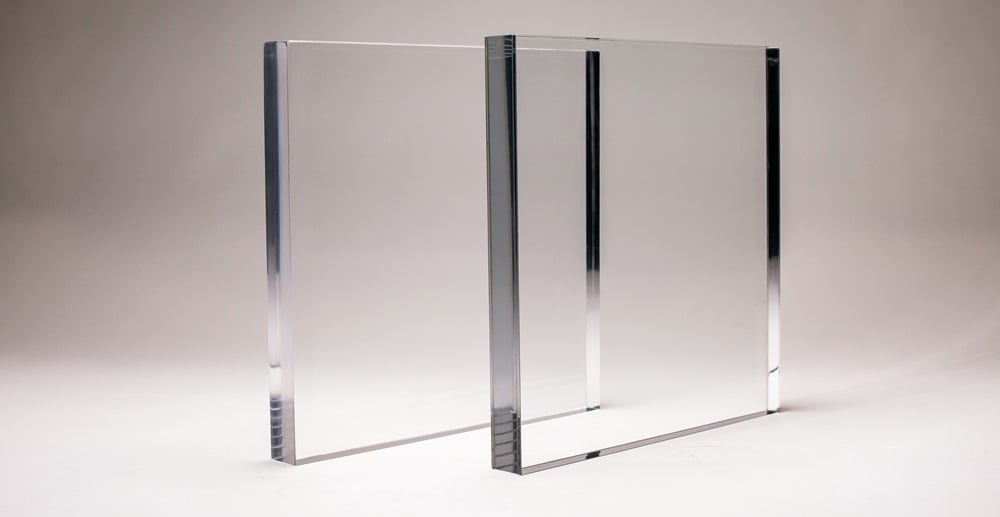What bulletproof glass is made of depends on the type of bulletproof glass—there are a few different types available. Our bulletproof glass products are made from acrylic, polycarbonate, glass, and adhesive interlayers in combination. These different makeups are typically fabricated into four types of bulletproof glass:
These four types of glazing offer a range of benefits based on their unique properties.
How the Four Types of Bulletproof Glass Are Made (and What Bulletproof Glass Is Made of)
How Acrylic Bulletproof Glass Is Made
Bulletproof monolithic acrylic is the most basic form of bulletproof glass. As its name suggests, acrylic bulletproof glass is a solid sheet of acrylic thermoplastic. Our bulletproof acrylic is formed through a process called extrusion. Once cut to size, we can add an optional coating to these acrylic sheets that protect the glazing from wear and tear as well as abrasive cleaners. Acrylic bulletproof glazing is available in Levels 1 and 2.
How Laminated Polycarbonate Bulletproof Glass Is Made
Bulletproof laminated polycarbonate glass is made by layering panes of polycarbonate and acrylic together. This makeup typically includes two polycarbonate layers and one acrylic center layer, or in some cases just multiple layers of polycarbonate. Between each layer is a thin adhesive film called an interlayer. For laminated polycarbonate, Thermoplastic Polyurethane (TPU) film is typically used as an interlayer. Once the layering of panes is complete, the entire stack is vacuum sealed to avoid contamination and hold the layers in place. Then, the glazing is placed vertically in a specialized high-pressure heating unit called an autoclave that heats and binds the elements together. The unique combination of heat, pressure, and material makeup give laminated polycarbonate bulletproof glass its bulletproof properties. Laminated polycarbonate glazing is available in Levels 1, 2, and 3.
How Glass-Clad Polycarbonate Bulletproof Glass Is Made
Bulletproof glass-clad polycarbonate (GCP) glazing is made by laminating panes of glass and polycarbonate materials together. This makeup typically includes multiple glass layers and one polycarbonate layer. Between each layer is a thin adhesive film membrane called an interlayer. A TPU interlayer is typical for GCP. In some higher level makeups, both TPU and Polyvinyl butyral (PVB) interlayer films may be used . From here, the lamination process is the same as used in our laminated polycarbonate products.
Unlike acrylic and polycarbonate glazing, glass-clad polycarbonate is available in Levels 1 through 8. Even though high levels of GCP glazing has ten-plus layers, the glass included in the makeup has a high level of clarity, making these high levels of glazing possible.
How Insulated Bulletproof Glass Is Made
Bulletproof insulated glass units (IGU) are a unique product. They contain an air gap that provides a critical thermal break. The IGU gap often contains normal air, but also may be filled with inert gasses such as argon to improve the insulating properties. Additionally, desiccant is often included to absorb moisture between the panes and prevent fogging. Sealing around the outside of an IGU is critical to maintain the purity of the gap space or dissipation of the inert gas. The process for creating insulated glass units is very similar to LP and GCP.
While IGS traditionally contain polycarbonate layers for increased protection, Total Security Solutions has introduced a new class of all-glass bulletproof insulated glass units. These all-glass IGUs contain no polycarbonate and use a specialty interlayer film to achieve ever increasing levels of protection. Ballistic IGUs are available in Levels 1 through 5.
Why the Makeup of Bulletproof Glass Matters
The various bulletproof glass makeups are what make them effective at stopping bullets. The hard components deform the bullet upon impact; the soft materials absorb and disperse the bullet’s energy. Sticky interlayers grab onto the bullet, and contribute to the protection level.
Bulletproof glass composition varies depending on the caliber and number of shots it’s rated to stop. For instance, UL Level 1, half-inch monolithic acrylic can stop three shots from a 9mm handgun—one of the most common handguns. A rifle firing a 7.62mm bullet has significantly more firepower—which is why it takes 2.5 inches of Level 8 glass-clad polycarbonate to stop shots at this caliber.
Rigorous Testing Is the Key to Ensuring Bulletproof Protection
Bulletproof glass must undergo rigorous testing to be considered bulletproof or bullet-resistant. You can’t simply glue panes of glass and acrylic together to create bulletproof glass. The process of making bulletproof glass requires a tremendous amount of precision and engineering to achieve, even with relatively simple components. If you’re looking for ballistic protection, our team is ready to help you get started hardening your security.
Learn More About Bulletproof Glass
To learn more about the different types of glazing, how they work, and what levels of protection they offer, download our free Ballistic Glazing Solutions Guide. This guide will walk you through everything you need to know about bulletproof glass and how TSS can help you meet your security needs. To get started, download the guide today.

